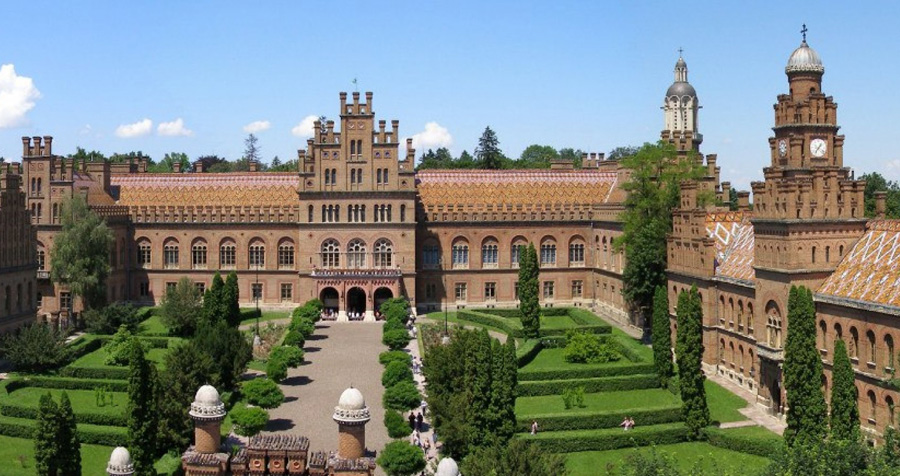
Turkish Krynitsa

The nice area of Turkish Krynitsa is a new site in Chernivtsy, displaying the multi-ethnicity of the city. In the 17th century in the downtown area just outside the city walls, there used to be a Turkish community. Next to the old wooden well the Turks built a stone fountain. Since ancient times, here was a public bath, that was still being used in Soviet times. On this site is a Turkish bridge (19th century), a well with above it a pavilion that was rebuilt in eastern style and a round arcade with a fountain in the centre. A beautiful decoration in the area is a ‘flower clock’; a clock on the ground, full of flowers. In 2009, on ‘the Day of blacksmiths’, an iron statue of a ‘velocipede’ was unveiled. They continue to restore the old buildings around the square. The Turkish Krynitsa is particularly beautiful when illuminated in the evening. (www.doroga.ua)
Bristol Hotel
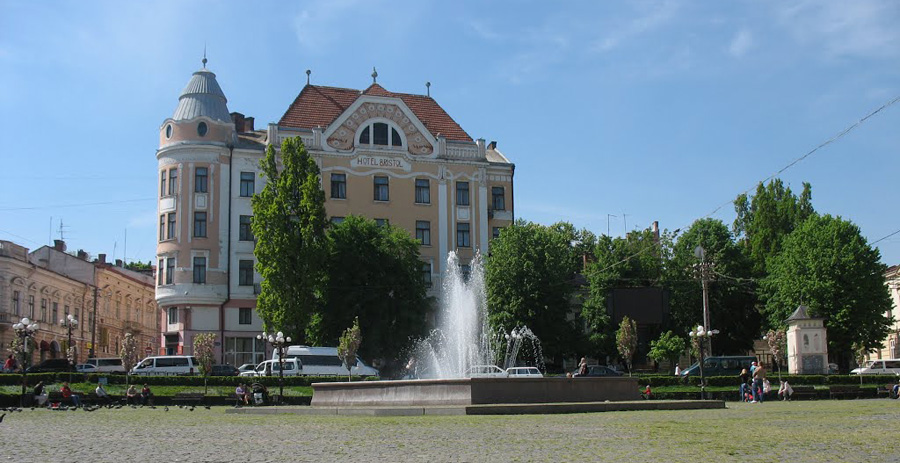
The Bristol Hotel was built during the Austro-Hungary period, 1905 — 1906, financed by Landau and Meisner. The four-storey, Art Nouveau-style building was one the most luxurious in the city; a dominant sight at the Theatre Square.
Currently, this building houses the hostel of the Chernivtsy Medical Institute. On ground level is a fast food restaurant. There are plans to restore the building to its original state. (chernovtsy.glo.ua)
Monument of Emperor Franz Joseph

Monument of Emperor Franz Joseph of Austria-Hungary is located in the park between the streets Korduba and Barhushina. During the reign of Franz Joseph (1848 — 1916), When Bukovina was part of the Austro-Hungarian Empire, Chernivtsy flourished. During his rule, Chernivtsy experienced a rapid economic and social development: railroads, trams and a power station were constructed and schools and also the university opened their doors.
The sculpture was created by Sergei Ivanov and V. Tsisarik. (chernovtsy.glo.ua)
Central Station
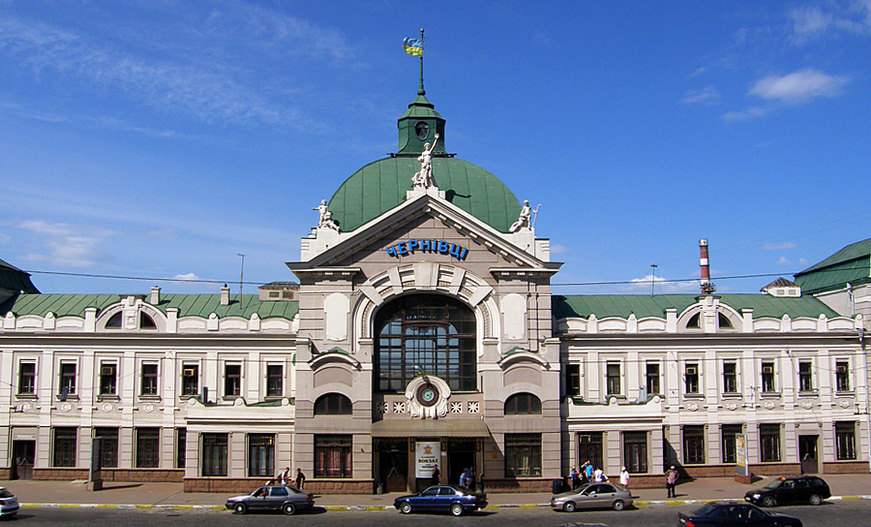
The building of the Central Station was built at the beginning of the 20th century. The style is consistent with the Viennese Art Nouveau, which was very popular at the time. The architect was O. Wagner. The structure is so wide, it can only fit in a picture using panoramic photography. Above the entrance is a large window, set in a steel frame, symbolizing the city gates.
According to many residents, the railway station has a similar shape and style as the Olga Kobylyanska Theater. Whether the architect had this in mind or this is just a coincidence, still remains a mystery. (chernovtsy.glo.ua)
Mountain Tsetsino
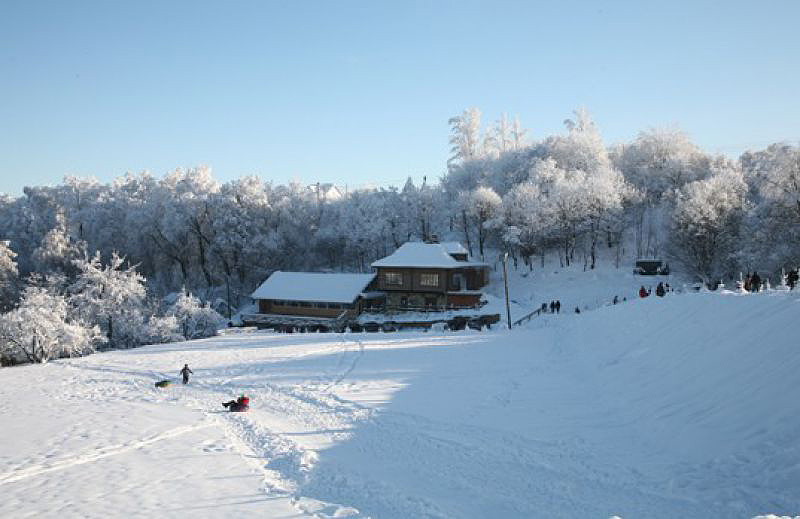
This is the highest point of Chernivtsy (378 m) on the western outskirts of the city. During the Middle Ages an impregnable fortress called Moldovan Tsetsino was on the top. Presumably it was built by a Galician prince, but later the fortress came into possession of Peter I Musat, lord of the Moldavian principality. In 1974, the Tsetsinsky park was built here, covering 430 hectares. Here grow rare varieties of trees (oak, beech, maple and holly), grasses and plants (listed in the Red Book). Also noteworthy is the fauna in the reserve. It is home to the European roe deer, wild pig, fox, marten, ermine and others. (chernovtsy.glo.ua)
Palace of Justice
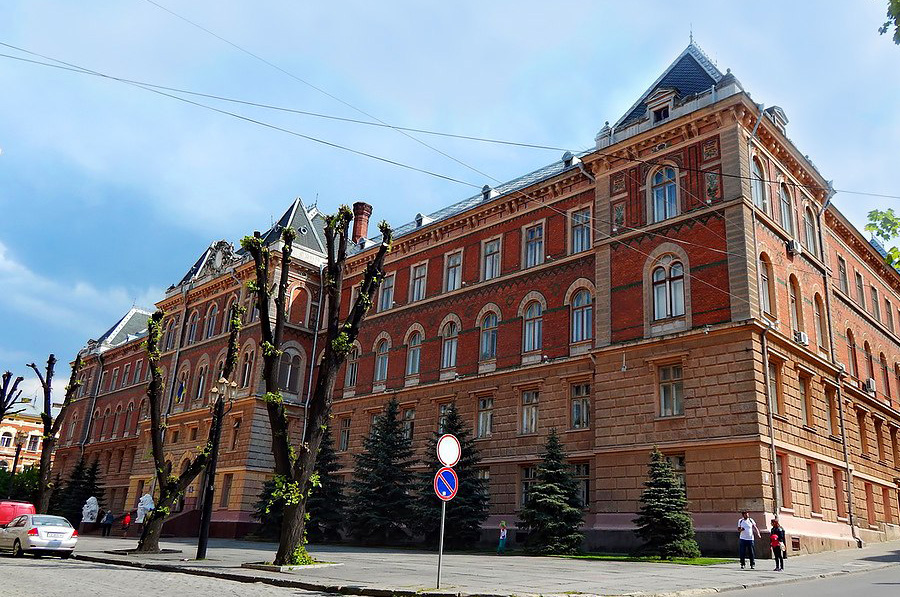
The Palace of Justice is a spectacular grandiose building on Grushevsky Street, designed by Joseph Glavka, who designed many other beautiful buildings in the city. Once, the Palace of Justice (now the building of Chernivtsy Regional State Administration) is a architectural monument of the 20th century. It is also called 'The House with Lions', because at the entrance are two sculpted lions. The walls are lined with colored bricks with ceramic inserts. The main facade is decorated with sculptures of the goddess of justice Themis and the goddess of retribution Nemizidy. (chernovtsy.glo.ua)
Phone: +38 (0372) 55-15-89
House of the General
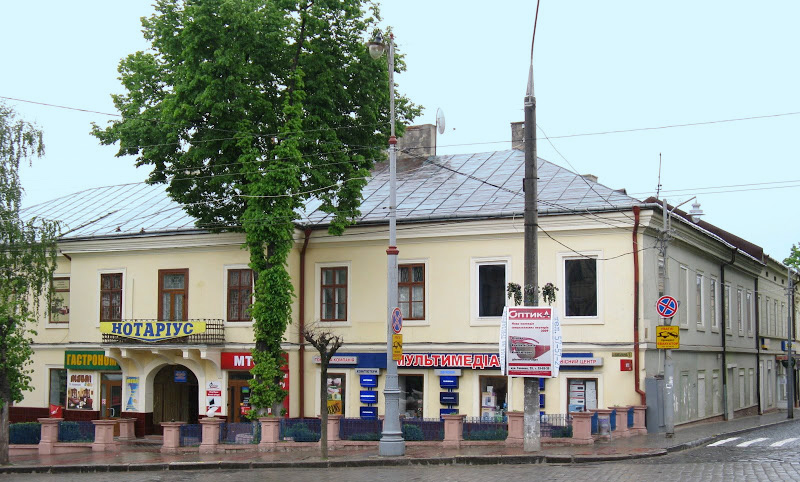
The House of the General is seemingly a simpel house at School Street 1. Externally it is no different from the typical two-storey eight-apartment houses, that were built during the Soviet era on the territory of Ukraine. However, there is one major difference: the building was erected in stone, not in wood, as was usual at the time. This house was built in 1780 for the Bukovina Governor, General Baron Karl von Entsenberg. The Baron put his mark on the history of the formation and development of Chernivtsy, as he paid attention to economical issues, not only in the city but in the entire region.
The Emperor of Russia, Alexander I, on his way to a meeting with the Austrian Cesar, Emperor Franz I, stayed at the general’s house in 1823.
Today, the building is rented out to tenants. On ground level are various stores and on the first floor are offices. (chernovtsy.glo.ua)
The Colonel’s House
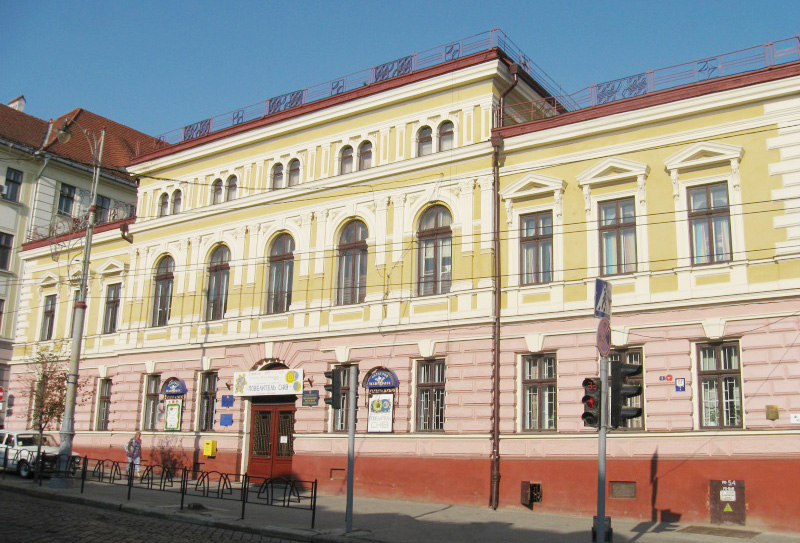
The Colonel’s House was the second stone building in Chernivtsy (the first being the House of the General). Built in 1782, it received its name after its first inhabitant. At the end of the 19th century it housed the officers' casino. Now it holds the Chernivtsy Regional Puppet Theater, that opened its doors on August 15, 1980. The aim of the Chernivtsi Regional Puppet Theater is to develop the aesthetic tastes of the young audience. The plays are about work, bringing up children, love for national culture, language and traditions of the region. (chernovtsy.glo.ua)
The Philharmonic
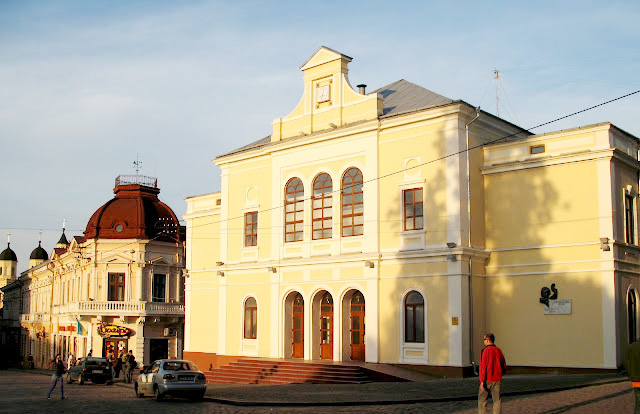
The Philharmonic (Musical Society) was created in 1862. 15 Years later a concert hall was built for them. Architect E. von Regius developed the project. Construction of the imperial-royal building was supervised by advisor A. Bulirts. The Philharmonic Hall was constructed in 1876 - 1877 as a concert hall for the Ukrainian musical society, through voluntary contributions (currently it is recognized as a monument of architecture). The painting of the Hall was done by Viennese artist Karl Jobst, who in the same period painted residences of Bukovina metropolitans. In 1940, the Chernivtsy Regional Philharmonic Society was founded in this building. In 2010, Chernivtsy celebrated the 70th anniversary of the Philharmonic. On this occasion restoration work was conducted on the premises. (chernovtsy.glo.ua)
Phone: +38 (0372) 52 43 38, +38 (0372) 52 55 09
Jewish House
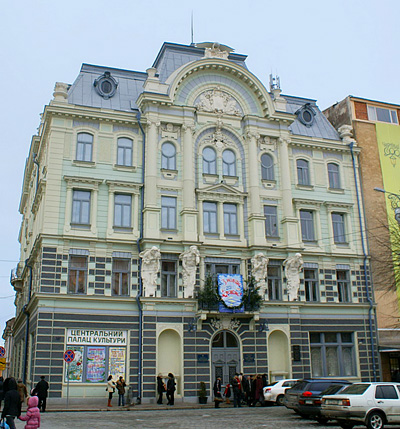
In 1908, architect Lewandowski constructed a Jewish national house, located on Theatre Square in Chernivtsy, to the right of the musical-drama theater. A well-known historical fact is that in 1774, when Bukovina came under Austrian patronage, in Czernowitz lived over 112 Jewish families. A relatively high number compared to other nations.
Because the Jews were the largest ethnic group during the early 19th century, the Jewish community got equal rights, just after the revolution of 1848 when Bukovina became a duchy. Mid-19th century, there were Jewish streets, a Jewish nursing home, the Choral Synagogue and they opened a school for Jewish children.
In 1941, during the first massacres large numbers of Jews were killed and many were deported to camps. After the war only one-fifth of the Jewish population remained. (chernovtsy.glo.ua)
Phone: + 38 (0372) 55 06 66
Ukrainian People’s House

The Ukrainian People's House was built in the late 19 century. It became the center of Ukrainian life in Bukovina. It was destined to play an important part in the revival of the Ukrainian language in the period before the First World War. The idea for establishing the Ukrainian society 'People's House' was officially anounced in 1875 at a meeting of the 'Russian Conversation' society.
The two-storey building has been the property of the Ukrainian society 'People's House’ for over 125 years. The building is an architectural monument and is protected by the state. The People's House issued periodic press, organized gala events and meetings with prominent cultural figures. Now, the building still belongs to this society. (chernovtsy.glo.ua)
Phone: +38 (0372) 4 51 02, +38 (0372) 2 58 52
The Philharmonic Square
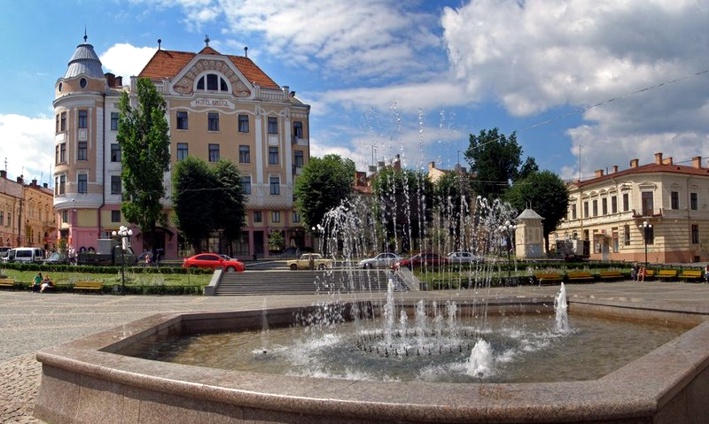
The Philharmonic Square became the center of musical life in the city. It has been here since 1876-1877. The house of the Bukovina Music Society (Philharmonic) was built here, where -among others- Lysenko, A. Rubinshtey and Sidi Tal gave their concerts. The former Bristol hotel with its stylized tower stands out at the square. On the 598 anniversary of the city, a musical fountain was set on the square. In the evening, a lot of people enjoy the sight of water and light dancing to the music. Khudyakov Street, leading from the square, will bring you to a historical post office, a beautiful building built in 1884-1889, with neo-classical shapes and figures from Greek mythology. On the 2nd floor, above the entrance is an old clock. (chernovtsy.glo.ua)
Town Hall
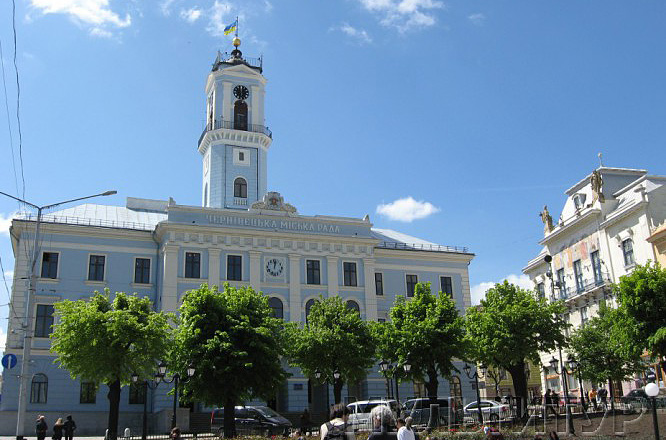
At the beautiful central square in the heart of the city stands Chernivtsy’s Town Hall in light-blue colours. The Town Hall was built in 1843-1847 in late-classicism style. For as many as 29 years the authorities tried to determine where the Town Hall would be built. After that, the city had to wait another six years before it was built.
In the architecture of the building you can see the transition from Classism to Italian Renaissance: the facade is designed in classic style, while the clock tower shows Renaissance motifs. The arcade (with rustic work) of the central facade of the building has six so-called Doric pilasters. The top of Doric pilasters symbolized warrior-guards, in ancient Greece.
The original plan was that the building would be a two-storey building, but during the course of construction, it was decided to build three floors. One of the Town Hall’s features is that is has two clocks. The tower has been installed directly into the structure of the building and the clock above the main entrance was a gift by Mayor A. Kochanowski, one of the most famous and respected politicians in the history of Chernivtsi Bukovina. He was mayor from 1866 to 1892.
On November 12 of 2004, introduced a new tradition was introduced: at exactly 12 o'clock on the tower spiral staircase, a trumpeter in traditional Hutsul folk costume plays the 'Marichka' song. (chernovtsy.glo.ua)
Phone: +38 (0372) 55-39-53
Ship House (Shifa)
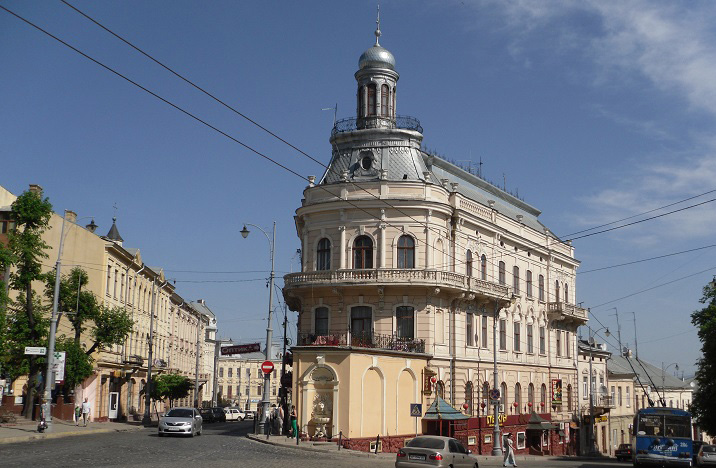
Legend has it that the Ship House was built by a local businessman for his brother, a sailor. So he wouldn’t miss the sea, he built the house resembling a ship. The open area on the first floor resembles the deck, the narrow facade resembles the bow, and a small tower on the roof resembles a pipe or a mast. According to local legend, the house was built by the brother of the wandering sailor, hoping to bring him home. The owners lived on the first floor, in the area equipped with two captain's bridges and two steering wheels. The brothers went back there every morning to exercise, but on holidays they wore dress uniforms and would stand at the handlebars at the helm.
It's a very nice story to believe, but there is of course a more traditional version of the Ship House. It tells us that at the end of the 18th century this quarter housed an inn called 'Zum Goldenen Shiff' ('At the golden ship'). With this inn as inspiration, the Ship House was built, still attracting visitors. (chernovtsy.glo.ua)
Bukovina waterfalls

The landscape reserve of 'Bukovina Falls' lies in the village of Roztoky, Putyla district. Here in the flow of the Smugariv stream, in a forested mountain gorge, are seven waterfalls of different heights (3-18 m) within 2 km, which is a unique in the Ukrainian Karpathian mountains. The seven waterfalls are called Kovber, Owl, Lower Gook, Gateway, Medium Gook, Big Gook and Supreme Gook. Kovber, wider than it is high (height 3.5 m), is named after the former owner of the city, who -when it still was Romanian- built a concrete wall for the water intake for a water mill. Nearby, 20 meters upstream is a vertical waterfall 10.5 m high; Owl. So named because of its special hiss of falling water. Slightly higher than Owl is the next one with a height of 9 m; Lower Guk. Almost a kilometer separates it from the top of the fourth waterfall, Gate measuring 3.5 m tall. After 250 meters you are met by Average Gook, 10.5 m high. Its sister, Big Hook, is 500 m further. It is the most beautiful and highest waterfall, here the water drops 19 meters down. The last, the seventh waterfall the five-meter Supreme Guk. The Bukovina waterfalls ranks in the top 10 of the '7 Wonders of Ukraine'. (chernovtsy.glo.ua)
View Square

Here you will have the most breathtaking panorama on the bank of the Dniester river on the opposite side of the city Zalishchyky. A high cliff above the Dniester river from where the dome of the Khreschatik Monastery can be seen. Bring your own snacks and drinks, because there are no facilities here.
Palace De Zotti
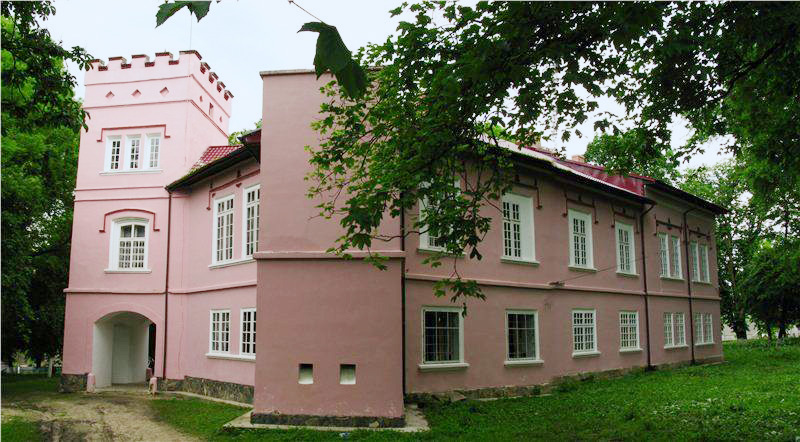
This palace was built in 1809 in the romantic style of Western Europe by a retired captain, the owner of the large estate in Okna, Baron de Zotti. The palace is surrounded by a park, founded in 1860. It is a monument of landscape art, where 28 species of rare trees grow. The palace was stylized after medieval castle architecture. The main facade has an arched gallery with wide openings. In Soviet times, the palace housed the House of Culture, worked as a cinema, a children's music school and a library was located in the tower. And in the years of independence, it was in poor condition. In 2006, at the occasion of its 200th anniversary, the Ukrainian government has allocated the area for restoration. (chernovtsy.glo.ua)
Mansion of Simonovic
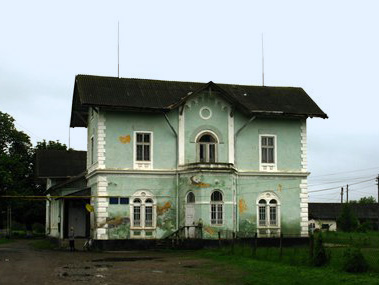
The Mansion of Baron Simonovic in Dubovtsev was built in 1914. The small two-storey manor in green is designed in Art Nouveau style. During Soviet times it housed the village club. Now this building is used by the Dubovtsev village council. chernovtsy.glo.ua)
Dubovtsev
Selyatinsky Farm Zoo
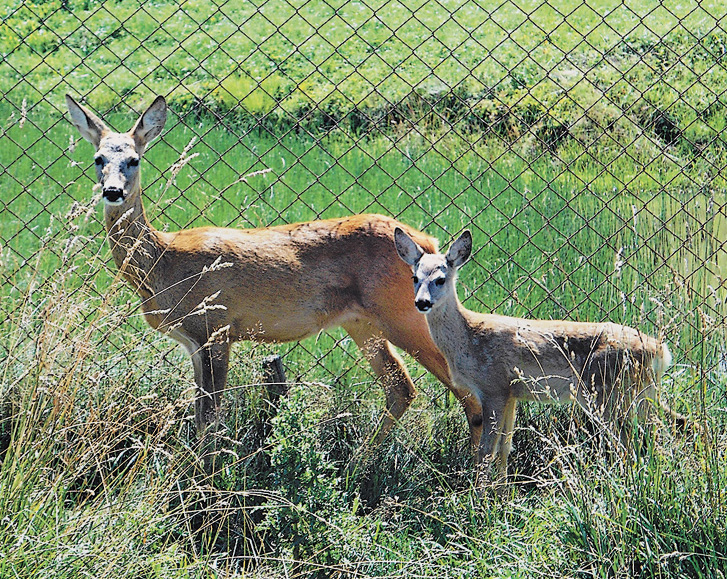
The State Enterprise "Putyla Forestry" includes 9 forests, including the Selyatinsky forest, where in 1995 a zoo was made, with wildlife from the Bukovina Carpathians. In this 'farm' live several animals, like bears, wolves, foxes, deer, wild boars, hares and eagles. Here you can spend a lovely day with friends and family. (chernovtsy.glo.ua)
Putyla district
Dovbush Cave
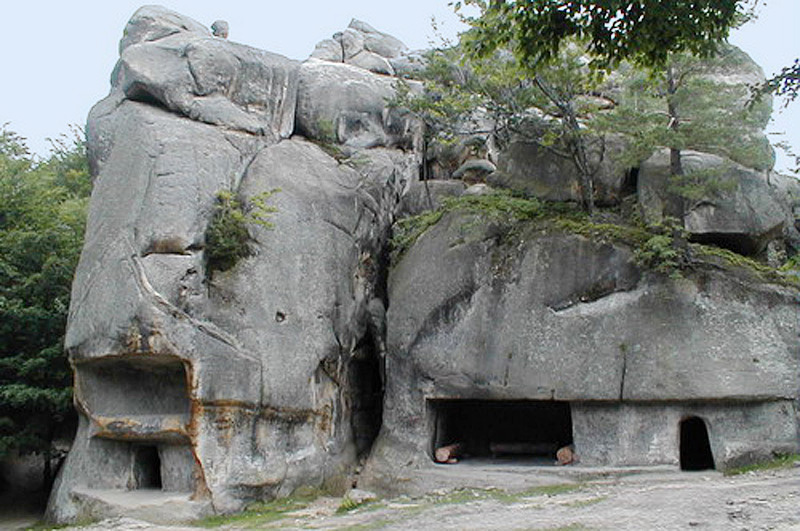
This cave, at the top of the mountain above Podzakharych, is named Dovbush in honor of the legendary people’s hero Oleksa Dovbush. According to legend, in 1740-1741, Dovbush acted with his detachment near the Pidzakharych and Roztok districts. This cave served as one of the shelters for the rebels. The ten-meter cave is a crack in the sandstone with a width of 1-1.5 m. Dovbush had three hundred goats, their fat was poured into skins and these were kept safe in the cave. They say that this fat -along with clothing, weapons and gold- is still hidden there, but also that it's cursed. When Oleksa died, those items were covered with slabs, hidden. Many were looking for it, but the cave is empty. (chernovtsy.glo.ua)
Falcon Eye
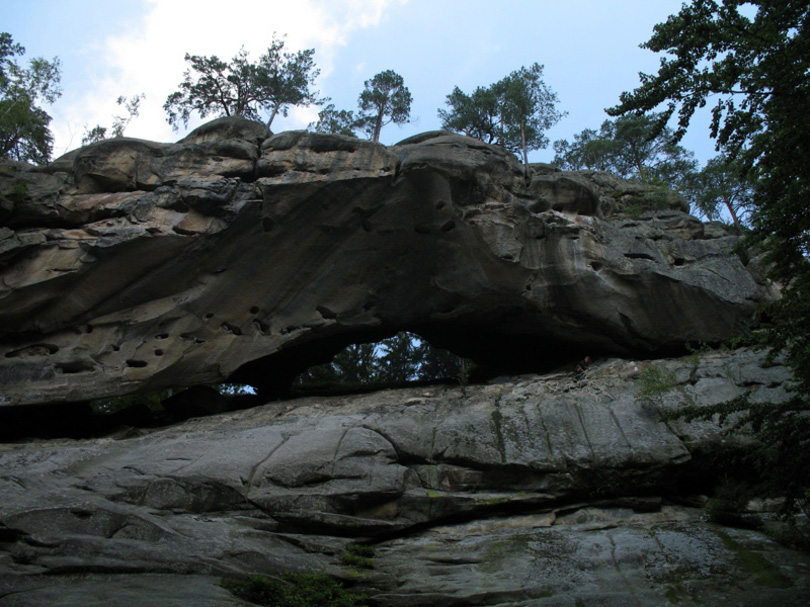
The Falcon Eye is a natural rock formation, formed by layers of sand. These layers are riddled with holes in different shapes. The punctured stones are an hour away from the Nimchich pass, a ridge between the rivers Smugarov and Vyzhenka (close to the village of Roztoky, Putyla district).
A legend tells, that in the distant past, the people living in the mountains had no easy way down to the valley. They decided to create a path by pouring boiling water on the rocks, dissolving the sandstone. Falcon's Eye - a stone 'arch' that looks like the eye of a bird. (chernovtsy.glo.ua)
Hawkeye Cave
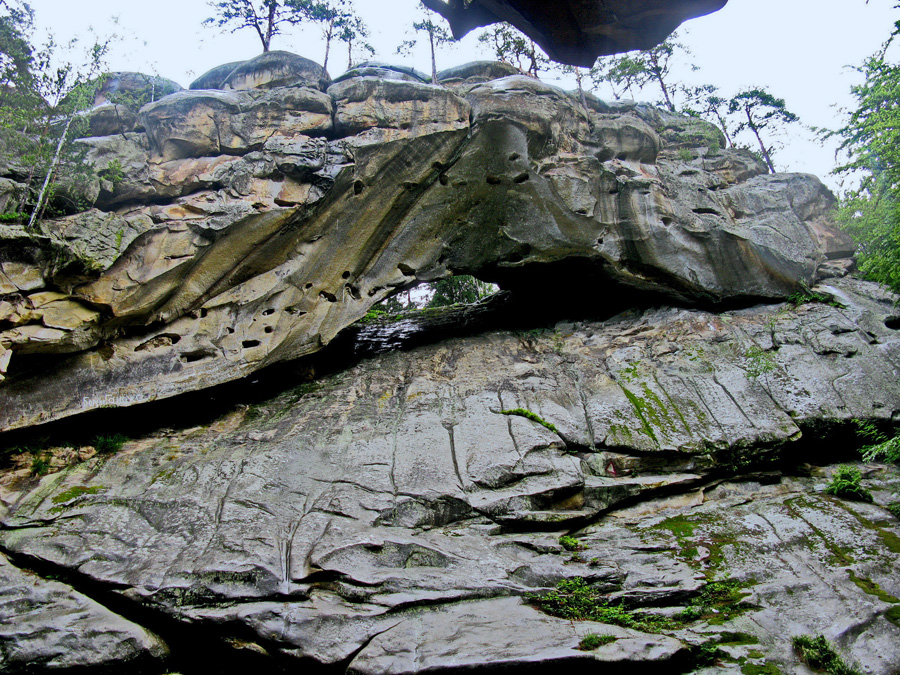
This is a stone 'arch' that really looks like a hawk’s eye, in a 40 meter high rock. At the foot of the rock on the north side is a small cave, that can be entered through two holes. Two other, much smaller, holes look out to the east. (chernovtsy.glo.ua)
The Rich Girl in Stone
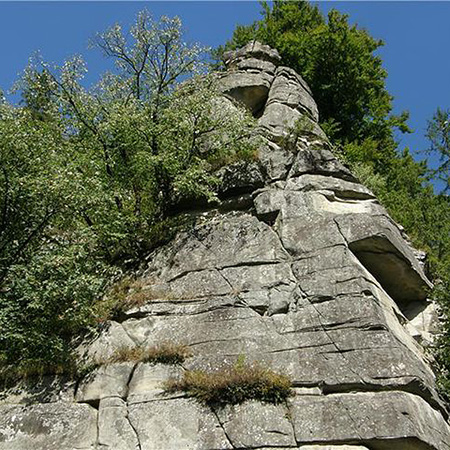
This rock is a geological formation, pyramid shaped and 30 meters tall. It actually resembles a human figure. 'Petrified Rich Girl’ is a rare case of weathering shapes, but of course the locals have a story to go with this rock.
In ancient times, a wicked and wealthy woman lived here. She learned that a blind old woman had a young daughter with unearthly beauty. She decided to take her as a slave. One day the old lady came to the rich girl and said: "Give me back my little child, so she can feed me bread until the day I die. I'm blind, old and my health is not well." The rich girl laughed and took out a stone, as big as a loaf of bread, from under her feet and handed it to the old woman. The old woman took the stone and said to the rich girl: "You will be a stone!" And she immediately turned into a rock.
So this large stone stands, reminding us of the consequences of human greed and abuse of the poor. (chernovtsy.glo.ua)
Equestrian club 'Bukovina Troy'
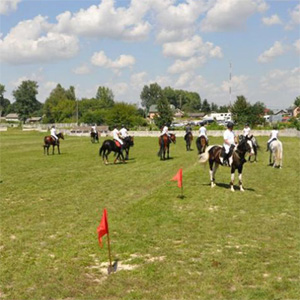
Horse-racing club 'Bukovina Troy', in the village of Revakovtsy in the Kitsman district, is the only place in Bukovina that combines professional elite sport and affordable recreation for children and adults, for advanced riders and for beginners. Horseback riding through woods and fields, accompanied by experienced instructors. The complex also has a restaurant, a mini-zoo, an ostrich farm, an outdoor aquarium, a summer terrace, a garden with barbecue and playground. You can also go fishing, quad biking and more. (chernovtsy.glo.ua)
Revakovtsy
Phone: +38 (067) 372-17-76, (0372) 02.10.90
Dniester Hydro Power Plant
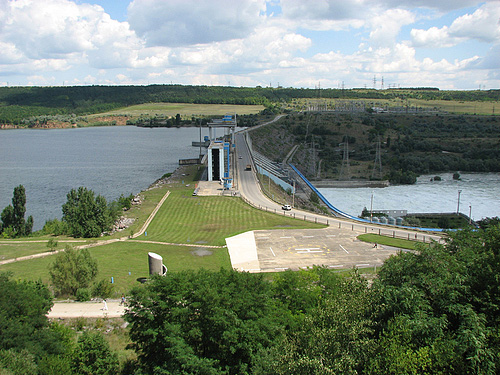
Hydropower in Ukraine began with the construction of the largest hydro-electric power station in Europe, the Dnieper Hydro Power Plant in 1927. One of the world's largest hydro-accumulation power plants is built in the Chernivtsi region on the Dniester river. Construction of the station began in 1983. The main two functions of the Dniester Hydro Plant are to regulate the frequency and power load in Ukraine’s power system and provide for an emergency reserve. Electric power of this station (7 pump-turbines) on average is 2268 MW, and 2947 MW in pumping mode.
In 1981, the first two hydraulic pumps were put into operation, and in 1983 the station had the capacity of 702 MW. In 2008, the first hydraulic generator of the Dniester Pump-Storage Power Plant was launched, making this facility the most powerful one in Europe. The reservoir with a length of 194 km can regulate the seasonal flow of the Dniester river. Novodnistrovsk in Western Ukraine on the banks of the Dniester River, is famous for its beautiful places and beautiful nature. Here you will have spectacular views. (chernovtsy.glo.ua)
Sokiryanskaya district
Phone: +38 (03741) 3-29-09, 3-20-33
Train station in Novoselitsy
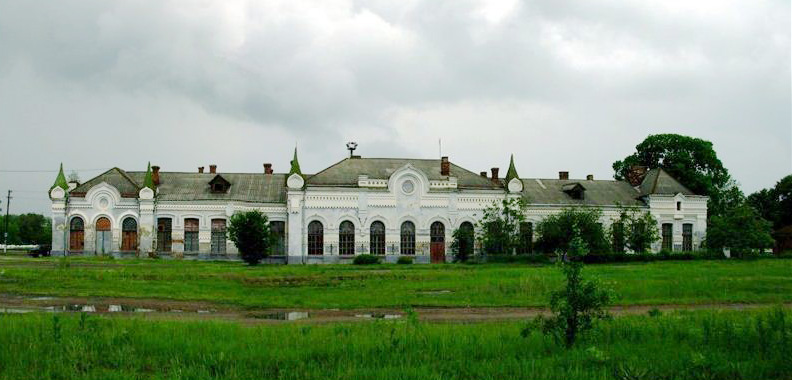
The one-storey building of the railway station Novoselitsy was built in 1905. It was here in 1915, when the American writer and journalist John Reed began his famous journey through the Russian Empire, described in his book 'The War in Eastern Europe'. (chernovtsy.glo.ua)
Kirov Street 9
Phone: +38 (03733) 02 05 58
BANDS AND SINGERS
Okean Elzy
Jamala
The Hardkiss
Tina Karol
Christina Solovy
Piccardysky Tertsiya
advertisement
Ruslana
Skryabin
Alyosha
Olexander Ponomarev
Zlata Ognevich
Onuka
advertisement
Antityla
Loboda
Irina Dumanskaya
Irina Fedishin
Vivienne Mort
Krykhitka Tsakhes
advertisement
S.K.A.Y.
Druha Rika
Boombox
Buv'ye
Lama
Platch Yeremy
advertisement
Voply Vidoplasova
T.N.M.K.
Tartak
Noomer 482
Braty Hadukyny
O. Torvald
advertisement
Bahroma
Epolets
Haidamaky
TIK
Ani Lorak






